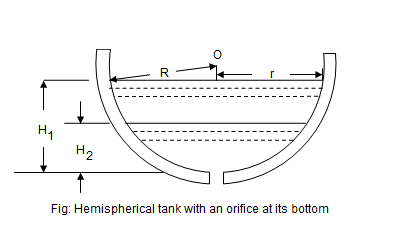Hemispherical
Time of emptying a hemispherical tank through an orifice at its bottom
Contents
At some instant, let the height of the liquid be h above the orifice.
We know that the theoretical velocity of the liquid at this instant,The value of dh is taken as negative, as its value will decrease with the increase in discharge.
We know that the volume of liquid that has passed through the orifice in time dt,
Example:
[metric]
Example - Time of emptying a hemispherical tank
Problem
A hemispherical tank of 2 meters radius contains water up to a depth 1meter. Find the time taken to discharge the tank completely through an orifice of 1000 mm2 provided at the bottom. Take  = 0.62.
= 0.62.
Workings
Given,

^{\frac{3}{2}}-\frac{1}{5}\times&space;(1)^{\frac{5}{2}}])

= 2m
= 1m
= 1000 mm2
= 0.62
Solution
Time taken to discharge the tank completely = 43 min 13 sec
 Login
Login


